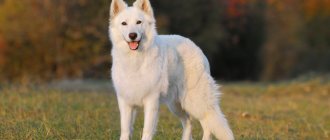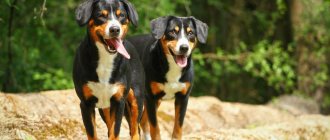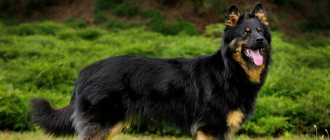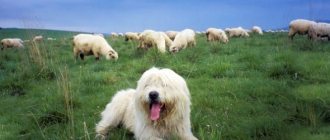A stately snow-white shepherd with luxurious fur and incredibly intelligent eyes is capable of captivating anyone at first sight. It’s hard to imagine that just a hundred years ago these beauties were considered a waste of the breed. The White Swiss Shepherd is not only a source of special pride for the owner, but also an excellent loyal friend. The beauty of a dog requires a special approach and care. All the details about this and other features of the breed are indicated in this article.
History of the White Swiss Shepherd breed
White Swiss Shepherd
The beautiful legend that the White Swiss Shepherd breed appeared due to the artificial crossing of a shepherd with a white polar wolf is far from the truth, although the dog’s caution, its ability to move silently, and its agility, indeed, give reason to assume a relationship with the white-haired inhabitant of the Arctic. In fact, the breed was formed as a result of the systematic breeding of a certain type of German shepherd, which had a white color.
In the German canine literature of the end of the century before last, shepherd dogs, the ancestors of German shepherds, whose distinctive feature was white, were often described. And the first “delegate” from German shepherds, who participated in the Hanover Dog Show in 1882, was a white male, whom the owners named Greif. Later, his grandchildren and great-grandchildren, who also had a white color, were demonstrated at dog exhibitions and championships held in Germany. By the way, the German shepherd with the great name Horand von Grafrath, officially registered under the first number in the pedigree book of this breed in 1899, also belonged to the Greif family. However, the color of the famous dog was yellow-gray.
Already by the beginning of the twentieth century, the German Shepherd was not considered an ordinary herding breed. Such remarkable qualities as strength, endurance, extraordinary intelligence, good trainability, and loyalty have brought this dog extreme popularity not only in Europe, but also overseas. Selection work was carried out very actively, the requirements for its service qualities and exterior grew, but until a certain time, no importance was attached to color, and white individuals were bred in the same way as others, without singling out in any way.
However, in the 30s, in their native land, Germany, white German shepherds found themselves in disgrace. The Nazis, who rose to the heights of power, established their manic control over such an area of human interests as dog breeding. They found the white gene to be responsible for all the defects, defects, defects found in German shepherds. The verdict turned out to be “tenacious”, and even after the fall of the Hitler regime on the European continent, white shepherd dogs were rejected until the 60s.
White Swiss Shepherd puppy
Meanwhile, overseas, in the USA and Canada, breeders continued breeding white German Shepherds, proclaiming that “there is no bad color on a good dog.” Spectacular snow-white dogs became increasingly popular, often appearing on television and becoming pets of famous people, such as the Rockefellers.
Since the 60s, many North American kennel clubs began breeding white shepherds as the original breed, and over time their mating with shepherds of other colors was banned.
Over the next decade, the dogs, now called American-Canadian White Shepherds, began to return to Europe. The first of them settled in Switzerland, where the development of the breed continued. The status of the founder of the Swiss breeding line is given to the male Lobo, brought from the USA, born in 1966. He and his descendants are registered in the Swiss Stud Book (LOS). Over the next few decades, an impressive number of purebred white shepherd dogs spread across Europe, and in 2003, on the initiative of Switzerland, the American-Canadian white shepherd was accepted into its ranks by the international canine organization FCI, but it received a different species definition, namely, the white Swiss shepherd dog Around the same time, the breed began to gain popularity in Russia, but today it is not one of the most common.
Owner reviews
Valery, 32 years old:
“Life with a White Shepherd is a life of constant adventure. A sharp mind and love for various pastimes make this dog an indispensable companion for both me and my two boys. And she definitely has a sense of humor! - Exactly!
Vasily, 53 years old:
“I have a descendant from the first “Swiss” in our country, brought here from the Czech Republic back in 2003. The pedigree says “FBCollet of Kim*s Dream”, and I am extremely proud of this record, although I understand that this is not my pedigree . It turns out that I am no stranger to vanity. By the way, the descendant himself is very cunning and resourceful, he calculates my every step and acts according to his calculations. A dog of extraordinary intelligence!”
Anna, 24 years old:
“Wool requires special care, not in terms of combing, etc., but because from an excessive amount of any substance in the diet (carrots, beets, seaweed, etc.), the wool turns yellow.”
Appearance of a White Swiss Shepherd
The appearance of the powerful and muscular White Swiss Shepherd is similar to that of an ordinary German Shepherd. They are almost identical in height, but the “Swiss” is built a little denser. Among the representatives of the breed there are long-haired individuals and those with medium-length hair. The former are distributed mainly in Germany, Austria, France, and the latter in Holland and the North American continent.
Frame
White Swiss Shepherd admiring his native Alps
The dog has an elongated croup, slightly inclined towards the base of the tail, and a strong, straight back. The chest is powerful, of medium width, oval in shape, deep, reaching down to the elbows, its front part is expressive. The abdomen is moderately tucked. The sides and lower back are strong. The withers are clearly expressed.
Neck
Muscular, slightly elongated, no dewlap. The line of the neck, gently transitioning from the rather high-set head to the withers, is nobly curved.
Head
The head of the Swiss Shepherd is proportional to the body, has straight, clean lines, and is wedge-shaped when viewed from above and from behind. The line of transition from the forehead to the muzzle is smooth, but the very place where they connect is clearly distinguishable. The powerful muzzle is elongated, slightly tapering towards the nose. The nose itself is medium in size, the preferred color of the earlobe is black, but a simply dark color is also acceptable.
Jaws, teeth, lips
Beach party
The jaws are powerful, the teeth are located strictly perpendicular to them. Scissor bite. The lips are an intense black color and should be dry and pressed tightly together.
Ears
They stand straight, set high, slightly directed forward. Their shape is V-shaped, the tips are slightly rounded.
Eyes
Small, slightly slanting, almond-shaped, color - from brown to dark brown, a black rim is welcome.
Muzzle of a white Swiss Shepherd
Limbs
Kiyayaya
The forelimbs of the Swiss Shepherd are strong, lean, and their bones are not too heavy. When viewed from the front, they appear to be set quite wide apart. The shoulder and forearms are elongated, with powerful muscles. The pasterns are strong and set slightly obliquely.
The hind limbs are muscular. From behind they look straight and parallel. The thighs are of medium length and well-developed muscles. The shins, with solid bones, are also muscular. The hocks are of medium length, straight, lean.
The dog's paws are oval in shape, with the hind legs slightly longer than the front ones. The fingers are clenched tightly and almost curled into a ball. The pads are elastic, black. The same color is preferred for claws.
Movement
The White Swiss Shepherd moves powerfully, measuredly, consistently rearranging its limbs. The dog's lynx creeps, as if sneaking.
Tail
Running Swiss Shepherd
Richly covered with hair, has a saber shape. Set on quite high and reaching at least to the hock joint, tapering towards the end. When the dog is in a calm state, the tail hangs towards the floor, sometimes curving slightly in the lower third. In an animated animal, the tail rises vigorously, but does not exceed the top line.
Wool
The animal's coat is thick, tightly covering the body. Both dogs with medium-length hair and long-haired dogs have an abundant undercoat. The outer hair is straight and somewhat coarse. On the ears, muzzle, and forelimbs the hair is noticeably shorter than in the neck area and the back of the hind limbs. The neck of long-haired Swiss Shepherds is decorated with a spectacular mane, and their hind limbs are dressed in woolen “pants”. A slightly wavy coat is acceptable.
Color
Only solid white color is recognized.
Breed defects
- Light yellow or fawn tint of color (fawn) in the back area, at the base of the tail, at the tips of the ears.
- Fragmented lack of pigmentation on the nose, lips, and rims of the eyes.
- Shortened, square-shaped body.
- Drooping or semi-erect ears.
- A curled or looped tail, a hook-shaped tail, positioned above the line of the back.
- Lack of undercoat. Too soft, velvety coat, as well as curly coat.
- Bulging eyes. One or both eyes are blue.
- Excessive aggressiveness or, on the contrary, timidity, timidity.
Features of feeding and diet
The White Swiss Shepherd has a good appetite and is not picky about food. But this does not mean that the owner should not monitor its diversity and balance.
The owner decides what to feed the pet. A dog will eat natural food or industrially produced dry food with equal gratitude. Here it is important to be attentive to the needs of the pet and its age.
So, puppies up to six months should be fed at least four times a day, starting from six months of the baby’s life and then switching to two meals a day. The norm is determined by the bowl. If it remains empty after feeding, then the amount of food is determined correctly. Otherwise, it is better to reduce the feeding rate.
You cannot feed a Swiss Shepherd dog food from the owner's table. There is no need to succumb to picturesque requests frozen in the eyes of your pet. Human food is very harmful as it contains preservatives and dyes that can cause skin dermatitis or food allergies in your four-legged friend. Excess portions lead to overeating, and subsequently to the development of obesity.
With a natural diet, most of the diet consists of meat products: beef, lamb, offal. They can be boiled or given raw. Porridge is also necessary for good digestion of the animal. Oatmeal, buckwheat or rice are best. It is useful to include boneless sea fish, vegetables and some types of pitted fruits in the menu.
It is recommended to give low-fat cottage cheese and fermented milk products to babies from the age of one month. No more than twice a month they are treated to a boiled egg.
We must not forget about vitamin-mineral complexes, which, on the recommendation of a veterinarian, are introduced into food.
When using dry food, you must carefully select the type. The main thing is that it is expensive premium food. They already contain all the necessary beneficial additives. We must not forget about the correct drinking regime for your pet.
Photo of a white Swiss Shepherd
Tips for choosing a puppy
The youth of the breed is the reason for the small popularity of the White Swiss Shepherd in Russia. It is impossible to buy a puppy of this breed at the poultry market or through an advertisement.
Unscrupulous sellers are trying to pass off light-colored babies of half-pedigreed dogs as purebred Swiss representatives. In fact, you can only buy a purebred puppy in special nurseries, where they provide the necessary documents about the pedigree of your future four-legged friend.
A healthy white Swiss Shepherd baby will be active with a shiny, soft coat. The coat should not be yellowish. The puppy's ears and eyes should be clean, without signs of inflammation. According to breed standards, the color of the irises is only brown. The nose is moderately cold and damp.
Ask the seller to show the parents of the future pet. Observe their behavior. They should not be overly fearful or overly aggressive. Ask about hereditary genetic diseases that your baby's relatives may have suffered from.
At the time of purchase, the puppy must have a veterinary passport indicating the date of the first comprehensive vaccination. White Swiss Shepherd puppies must be treated for worms while still in the kennel.
Personality of the White Swiss Shepherd
The White Swiss Shepherd is dynamic, temperamental, active and, at the same time, distinguished by its balance. Its character is softer and more reserved than that of the German Shepherd, but, despite its good nature, in the event of a threat to its owners and home, it displays the same qualities as its more aggressive relatives. In fact, white shepherds have all the character traits that a service dog has: strength, tirelessness, excellent reaction, intelligence. They are often used as guard dogs, rescue dogs, guide dogs, and bodyguards. Temperamental and cheerful, they are partial to sports, adventure, travel, and simply love to swim and play ball.
White Swiss Shepherd with his beloved owner
White Swiss Shepherd with cat
Affectionate and playful, White Swiss Shepherds get along well with all family members, including pets, including cats. They treat children very carefully, and perceive their pranks with condescending understanding. When interacting with babies and animals smaller than itself, the shepherd often displays herding instincts and begins to “herd” them, diligently and vigilantly taking care of them. Dogs of this breed prefer not to come into contact with strangers, they do not clearly express their wariness towards them, and they remain distinctly aloof.
Gentle White Swiss Shepherds really need the attention of their owners, their affection, they also love to “talk” and have a penchant for “vocal exercises”. It is worth noting that the range of their vocal signals is very wide, and sometimes they produce entire arias, the tonality and volume of which depends on their state of mind: these can be whimpers, grunts, moans or calls.
White Swiss Shepherd in a lavender field
Standards, standards, standards...
In 1995, the standard, in force since 1991, underwent changes.
Today, the standard “Swiss Shepherd Breed Description” with the qualitative characteristics of the BShO looks like this:
- the size and body of the shepherd dog reaches BUT standards, but can exceed them by 1.5-3 cm;
- the same applies to the weight of an adult animal - from 25 kg.
The behavior and main characteristics of the BShO breed are in many ways similar to the breed data of the German Shepherd (old type); the exterior is also similar - the slope of the topline is less, it may be absent altogether, but the croup never extends beyond the highest point on the withers.
The White Shepherd received the name Swiss because it was Swiss breeders who made the greatest contribution to the development of the breed
Despite the fact that among representatives of white Swiss shepherds there are 2 variants of coat length (short-haired and long-haired), they can be called long-haired conditionally - the length of the blood hair is not allowed longer than 6.5 cm. The hair must be hard, straight, and equipped with a thick, dense undercoat. Long-haired dogs have a mane and feathering - a desirable feature of the breed.
Completely smooth-haired animals with hair length less than 1.5 cm are not allowed for breeding.
Opinions about the length of the coat are divided: in Europe they advocate for medium-long wool, in America the standard is a close-fitting coat.
The color is always the same and the only acceptable one is exclusively white with dark lobes, edging of the lips, eyes and eyelids. Super - all paw pads and nails are very dark, ideally black.
White Swiss is by no means an albino! She does not lack melanin in her blood, and the best proof is the presence of the obligatory dark pigmented areas on the dog’s body.
The behavior and character of the BShO are similar to the behavior and character of the IO. Ideally, the result is a shepherd dog that is moderately curious, attentive, without signs of pronounced aggression, but cowardly behavior is also excluded.
The dog is indifferent and reserved towards strangers, but loyal and friendly to the owner and his family.
He learns all stages of training easily, playfully, but requires constant attention from the owner - he likes to play pranks during classes or “get into trouble.”
Education and training
Raising and training Swiss Shepherds is a real pleasure. They understand and remember the owner’s commands instantly, and their lively intelligence and enthusiasm accelerate the acquisition of certain skills by the animals. Training requires consistency and consistency.
It is unacceptable to use brutal training methods in relation to white Swiss shepherds, and there is no need for this - the dogs are obedient from birth. Often the owners themselves do not want to scold and punish their pets, especially when they are at a tender age, representing cute snow-white angels. However, you should not forget that this is not a lapdog, but a future serious service dog in need of training.
It is important to remember that mistreatment and lack of socialization and training can cause aggression towards people and other animals. The owner of a White Swiss Shepherd will need calmness, consistency in actions and confidence in himself and his abilities.
Description of character
In addition to a high level of intelligence, the white shepherd shows extraordinary obedience and responsibility. For this reason, they are considered to be easy to train. This dog is very inquisitive. She will happily follow you wherever you go, watching your actions with interest. A cheerful and sociable character allows you to establish contact with the dog almost at first sight.
They are ready to communicate with strangers (although at first they are very wary), and they happily play with children. In addition, such a pet will also get along well with other four-legged friends in the house. It is believed that white shepherds can talk. They communicate with their owner using a wide range of sound signals, which often surprises random passers-by.
Care and maintenance
Training a White Swiss Shepherd
Grooming a White Swiss Shepherd is not difficult. Even a dog’s thick coat, regardless of its length, can be kept in order without making excessive efforts. She will require special care during the molting period. During this time, the dog should be brushed at least twice a week, using sprays specially designed for removing hair. Short-haired animals are combed with a fine comb. It is advisable to first comb a long-haired pet with a sparse comb, then, if necessary, untangle or cut out tangles, then comb it with a fine-toothed comb, and finally treat it with a massage brush made of natural bristles. At the end of the procedure, it is advisable to run wet hands over the fur several times to remove any remaining dead or combed hairs.
Once a week, your pet will need to brush its teeth using a toothpaste designed for dogs. The movements should be sweeping - from the base of the teeth to their edges. It is advisable to wipe your eyes with a damp cloth every day; your ears can be cleaned twice a month with a regular cotton swab. Shepherd dogs' nails are trimmed, as a rule, once every month to a month and a half; a nail clipper is used for this purpose. If you are not used to this tool, you can injure your claws. We advise you to contact a specialist in the first months and observe the procedure.
Frequent bathing of a White Swiss Shepherd is not recommended, regardless of the color of its coat. Typically, general washing occurs twice a year. However, after a walk in bad weather, the dog’s paws and belly should definitely be washed; it is also necessary to clean the contaminated areas of its coat - this can be conveniently done with dry shampoo.
Will you play with us?
Shepherds need regular exercise and should be taken for walks at least three times a day. The dog will be delighted if, during a walk, he gets the opportunity to run after a ball or stick, swim, catch a flying disc, and frolic in the company of his fellow breeders.
The White Swiss Shepherd has a good appetite and is not picky about food. You can feed her both natural products and ready-made food. It is advisable to treat your pet at the same time. Two to four month old puppies are fed 4 times a day, and by the age of six months they gradually switch to two meals a day.
Most of the diet of a dog eating natural foods should be meat - lamb or beef. It can be given raw or scalded with boiling water. In small quantities, the Swiss Shepherd's menu should include steamed vegetables, porridge (rice, buckwheat, oatmeal - separately or assorted), low-fat cottage cheese and kefir, and sea fish. Twice a week you can offer your pet a boiled egg or a raw yolk. Beef liver is also a healthy food.
Dry food for a white Swiss shepherd needs to be selected. First, purchase a small bag of a specific food for this breed and check how much your pet likes it, and whether he has any allergies.
Pros and cons of the breed
| Advantages | Flaws |
| Reserved with strangers, very fond of family members | Due to the lack of pronounced aggression towards humans, they have less pronounced protective qualities than, for example, the Caucasian Shepherd Dog. However, they are capable of attacking if the stranger clearly provokes it and poses a threat to the owner or family members |
| Does not require special care | During periods of shedding, BShO needs to be combed daily. |
| Sociable and playful dogs | Not suitable for people prone to a passive lifestyle |
| Suitable for couples with small children | |
| Get along well with pets | |
| Easy to train due to high intelligence and tendency to obedience | |
| Very healthy dogs |
The White Swiss Shepherd is a wonderful companion and family member. This breed has a non-aggressive character and extraordinary intelligence.
The dog is perfect for active families with small children. BShO are distinguished by good health, which means they will delight their owners for many years.
Expert opinion
Leonid Rodin
Experienced dog breeder
Ask a Question
Unfortunately, many myths have taken root about White Swiss Shepherds. The reason for this is their close relationship with German dogs, from which the BShO - at a superficial glance - is distinguished only by the color of their coat. The White Swiss Shepherd will not demonstrate the innate guarding qualities of its Germanic relative. The breed lacks the ability to quickly become excited and become aggressive. And without this, the dog does not pose any threat to the enemy. The learning ability of BShO also has a number of specific features. With the appropriate approach, they are indeed able to quickly learn commands, but just as quickly forget them. Therefore, the OKD course must be repeated regularly. All of the above is the result of selection in the Russian line. Breeders pay more attention to the properties of a companion dog than to cultivating service qualities. The White Swiss Shepherd works best as a family friend, everyone's favorite and the center of attention.
Health and Diseases of Swiss Shepherds
As has long been known, the white color of a dog does not at all mean that it is characterized by physiological pathologies. The White Swiss Shepherd, like the German one, is a very strong animal, characterized by good health. However, hereditary diseases are the same as those of her closest relatives, although such a common defect among the “Germans” as hip dysplasia is much less common among the “Swiss”. Other diseases common to breeds include:
- eosinophilic panostitis - colloquially a growth disease, expressed in lameness and characteristic of animals 5-12 months old;
- paresis of the pelvic limbs, manifested in limited motor ability;
- intussusception is one of the forms of intestinal obstruction;
- congenital heart failure.
Shepherds also have a predisposition to diabetes and various types of allergic reactions.
I got a little dirty here
BShO puppy with mom
What is the breed for?
These dogs were bred to be herders. After all, their color helps them practically “merge” with the herd of snow-white sheep, so that a predator may not immediately notice them. And these shepherds cope well with their shepherding duties. In addition, the white German Shepherd can be an excellent watchdog, family guard and your companion. Representatives of this breed are very hardworking and intelligent.
How to choose a puppy
The White Swiss Shepherd is a young breed and is not yet very popular in Russia. Many dishonest breeders take advantage of this and sell white puppies of unknown origin under the guise of white shepherd dogs. To buy a purebred cub of this breed, you need to contact specialized nurseries, which are found in almost all Russian cities with a population of over a million. They will be able to provide you with documents indicating the dog’s pedigree.
A healthy puppy should demonstrate activity, have shiny fur, curious eyes, and no discharge in the ears and corners of the eyes. Pay attention to eye color. They should be brown, not blue. Excessive thinness or a bloated tummy is a reason to be wary. Feel free to ask the White Swiss Shepherd breeder any questions - a professional who loves his job will answer each of them with enthusiasm.
Ask for test results from your future pet's parents for genetic diseases, particularly hip dysplasia. It would also be useful to observe the behavior of the puppy’s mother, who, as a rule, is with him in the kennel. The dog is unlikely to show affection towards you, but it should behave with restraint, showing neither aggression nor fearfulness.
Interesting fact
The history of the American food production company ROYAL CANIN began with the creation of the ROYAL kennel, where the emphasis was on breeding the White Shepherd, deliberately not using shepherds of a different color in matings.
They were the first to encounter the problem of yellowing fur in their dogs. Then, in 1967, veterinarian Jean Katari was given an order to develop a complete food mixture for white shepherd dogs, eliminating the appearance of yellow pigment.
Jean Katari coped with the task, and in 1968 the first production line for the production of food for the White Shepherd was opened and the ROYAL CANIN brand was registered.
Later, production lines were opened for all shepherd dogs, and a couple of years later - for all types and breeds of dogs.
Photos of White Swiss Shepherd puppies
Origin story
During the Enlightenment of the 18th century, the German states were covered by a wave of crimes, so the question arose of creating a special service dog to help the police.
One cynological community, Philax, has set itself the goal of developing a new breed from local herding shepherd dogs from different regions of Germany (Thuringia, Bavaria, Württemberg and Saxony).
Constantly subject to criticism about what the next breed should become in the final version, the community itself did not last long.
However, it still managed to leave important developments on white shepherds:
- drew attention to the value of many qualities inherent in herding dogs;
- developed a certain view on the required type of police service dog.
Smart pets with a snow-white color quickly won the hearts of private dog breeders. Rumors about the new breed quickly spread beyond the country, and puppies began to be sold to the UK, and from there to Canada and America.
NOTE!
The descendants of the German Shepherd carry the white gene in a latent state, so each subsequent mating in 90% of cases out of 100 will necessarily produce one or more puppies of the required shade in the litter.
Left without strict control from professional dog handlers, amateur breeders made every effort to breed shepherd dogs that are in greatest demand - light-haired ones.
Today, the white color, which almost destroyed the breed in Germany as a glitch in genetics, has become one of the reasons for its popularity. Fans of non-standard species get white shepherds primarily because of their unusual appearance and character inherent in a real working dog.
How much does a White Swiss Shepherd cost?
The cost of a White Swiss Shepherd puppy depends on what class of pet you are interested in.
Thoroughbred babies with a pet-class pedigree, aspiring only to become pets, can cost from 25,000 to 35,000 rubles in different cities of Russia. For a breed-class Swiss shepherd that can be used for breeding, you will have to pay from 30,000 to 40,000 rubles. The most expensive ones are show-class “Swiss” ones, which have an exhibition perspective. They cost from 40,000 rubles and above. A puppy without a pedigree can be purchased for 15,000 rubles.
Health
On average, white shepherds can live 11-15 years.
Nature has awarded the shepherd with good health, but not everything depends on natural data. The owner must take care of the pet and monitor its condition. Only in this case can the dog live the maximum number of years.
The dog owner's responsibilities include:
- Annual visit to the veterinary clinic for preventive examinations.
- Deworming.
- Carrying out routine vaccination.
- Regular treatment with drugs against skin parasites.
Every dog owner should be aware of their pet's predisposition to certain diseases. Below are the diseases that are most often observed in white shepherds:
1. Dysplasia of the elbow and hip joints - characterized by pain and lameness in the initial stages, at the last stage the dog faces complete or partial immobility with unbearable pain. 2. Allergies – an allergic reaction to food most often occurs; there may also be an allergy to fleas and care products. 3. Congenital diseases of the spine are abnormalities in the development of the number or structure of vertebrae (scoliosis, lordosis, kyphosis).
4.
Autoimmune diseases are an attack of the immune system against the organs and tissues of the body’s own, resulting in their structural and functional damage. 5. Exocrine pancreatic insufficiency - can develop at any age, but more often in individuals under 4 years of age. 6. Osteoarthritis – leads to abnormal development of the hip joint, damage to the cruciate ligaments, knee dislocation and joint damage. 7. Von Willebrand disease is a hereditary blood disorder. 8. Cauda equina syndrome is a serious neurological disorder. 9. Degenerative myelopathy - caused by impaired conduction of motor neurons in the spinal cord.
Key points in training
BShOs are highly trainable and are considered one of the smartest breeds. Given the exceptional attention and respect for the owner, the assimilation of commands occurs quickly and without conflict. Dogs show good results almost 2-3 times, instantly remembering the sequence of necessary actions.
The most important thing from the point of view of mental and physiological maturity is the age of the puppy up to 9-10 months. Therefore, it is necessary to teach him the basic commands during this period.
Read about how to properly train a dog in the article: “Training a puppy: effective methods from dog handlers, learning commands at home.”
Forceful methods, coercion, and rude commands are excluded from the training process.
Price range
The average cost of a puppy ranges from 15-45 thousand rubles.
The final cost is formed under the influence of various factors - the region of purchase, the color and age of the dog, the presence of a pedigree and titled parents.
In the capital, puppies of this breed are sold for a higher price than in the provinces, and purebreds are much more expensive than mixed breeds.











